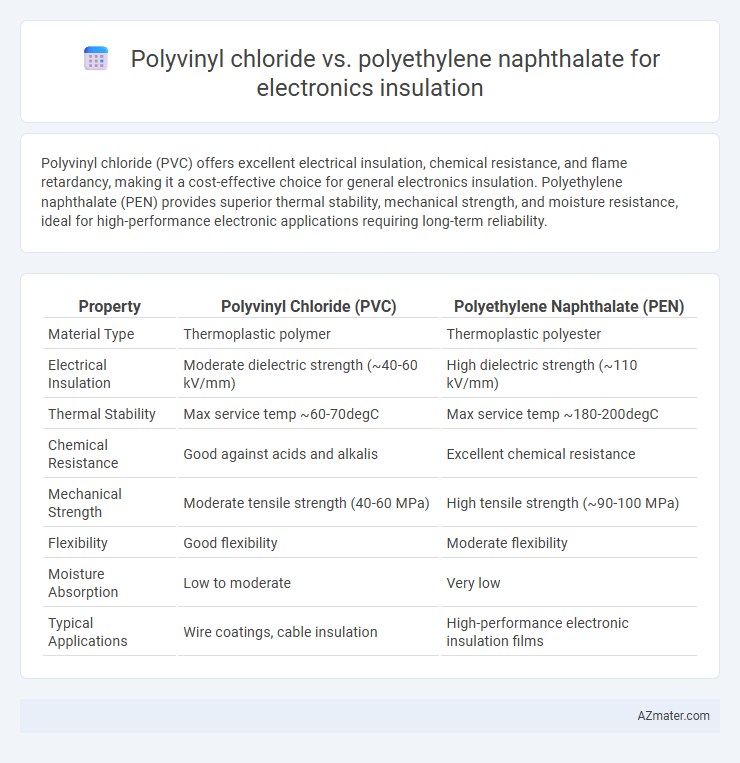Polyvinyl chloride (PVC) offers excellent electrical insulation, chemical resistance, and flame retardancy, making it a cost-effective choice for general electronics insulation. Polyethylene naphthalate (PEN) provides superior thermal stability, mechanical strength, and moisture resistance, ideal for high-performance electronic applications requiring long-term reliability.
Table of Comparison
| Property | Polyvinyl Chloride (PVC) | Polyethylene Naphthalate (PEN) |
|---|---|---|
| Material Type | Thermoplastic polymer | Thermoplastic polyester |
| Electrical Insulation | Moderate dielectric strength (~40-60 kV/mm) | High dielectric strength (~110 kV/mm) |
| Thermal Stability | Max service temp ~60-70degC | Max service temp ~180-200degC |
| Chemical Resistance | Good against acids and alkalis | Excellent chemical resistance |
| Mechanical Strength | Moderate tensile strength (40-60 MPa) | High tensile strength (~90-100 MPa) |
| Flexibility | Good flexibility | Moderate flexibility |
| Moisture Absorption | Low to moderate | Very low |
| Typical Applications | Wire coatings, cable insulation | High-performance electronic insulation films |
Introduction to Polymer Insulation in Electronics
Polyvinyl chloride (PVC) and Polyethylene naphthalate (PEN) are widely used polymers in electronics insulation due to their distinct electrical and thermal properties. PVC offers excellent flame retardance and flexibility, making it suitable for general-purpose insulation in wiring and cables, whereas PEN provides superior thermal stability, higher dielectric strength, and enhanced dimensional stability favored in high-performance electronic components. The choice between PVC and PEN in electronics insulation depends on specific application requirements, such as operating temperature, mechanical endurance, and chemical resistance.
Overview of Polyvinyl Chloride (PVC)
Polyvinyl Chloride (PVC) is a widely used thermoplastic polymer known for its excellent electrical insulation properties, chemical resistance, and mechanical durability, making it a popular choice in electronics insulation applications. Its inherent flame retardancy and good flexibility allow it to effectively protect wiring and components from environmental stressors. Compared to Polyethylene Naphthalate (PEN), PVC offers cost-effectiveness and ease of processing, though it may have limitations in thermal stability and long-term performance at elevated temperatures.
Introduction to Polyethylene Naphthalate (PEN)
Polyethylene naphthalate (PEN) is a high-performance polymer known for its superior thermal stability and excellent electrical insulation properties, making it ideal for advanced electronics insulation applications. Compared to polyvinyl chloride (PVC), PEN offers enhanced chemical resistance, higher dimensional stability, and better moisture barrier characteristics. These attributes contribute to longer-lasting, more reliable insulation materials in electronic devices operating under demanding conditions.
Key Material Properties: PVC vs PEN
Polyvinyl chloride (PVC) offers excellent flame retardancy and good electrical insulation properties, making it a cost-effective choice for electronics insulation. Polyethylene naphthalate (PEN) exhibits superior thermal stability, higher mechanical strength, and better dimensional stability compared to PVC, allowing PEN to withstand higher operating temperatures and harsh environmental conditions. While PVC is flexible and easy to process, PEN provides enhanced durability and chemical resistance, ideal for high-performance and long-term electronics applications.
Electrical Insulation Performance Comparison
Polyethylene naphthalate (PEN) exhibits superior electrical insulation properties compared to polyvinyl chloride (PVC), including higher dielectric strength and better thermal stability, making it more suitable for high-performance electronics insulation. PEN has a dielectric constant typically around 3.0-3.5 and can maintain insulation integrity at temperatures exceeding 150degC, whereas PVC's dielectric constant ranges between 3.5-4.0 with lower thermal tolerance near 70-105degC. These factors contribute to PEN's enhanced resistance to electrical degradation and longer service life in advanced electronic applications.
Thermal Stability and Heat Resistance
Polyethylene naphthalate (PEN) exhibits superior thermal stability and heat resistance compared to polyvinyl chloride (PVC), making it more suitable for electronics insulation applications exposed to high temperatures. PEN maintains structural integrity and electrical insulation properties at elevated temperatures up to approximately 180-200degC, whereas PVC typically degrades above 100-120degC, releasing harmful hydrochloric acid fumes. The enhanced thermal resistance of PEN ensures longer lifespan and reliability in demanding electronic environments.
Durability and Longevity in Electronic Applications
Polyvinyl chloride (PVC) offers good chemical resistance and flexibility, but tends to degrade faster under high temperatures and UV exposure, limiting its durability and longevity in electronic insulation. Polyethylene naphthalate (PEN) provides superior thermal stability, high tensile strength, and excellent resistance to moisture and chemicals, resulting in significantly enhanced durability and extended lifespan in demanding electronic applications. PEN's advanced polymer structure ensures reliable insulation performance under prolonged electrical and mechanical stress, making it a preferred choice for long-term electronics insulation.
Environmental Impact and Recycling Aspects
Polyvinyl chloride (PVC) in electronics insulation poses significant environmental challenges due to its chlorine content, which releases toxic dioxins during incineration and hinders recycling efforts. Polyethylene naphthalate (PEN), a high-performance polyester, offers enhanced recyclability and lower environmental impact, as it produces fewer hazardous emissions and supports closed-loop recycling systems. The superior thermal stability and chemical resistance of PEN also contribute to prolonged device lifespan, reducing electronic waste accumulation.
Cost Analysis: PVC vs PEN for Electronics
Polyvinyl chloride (PVC) offers a lower initial material cost compared to Polyethylene naphthalate (PEN), making it a cost-effective option for budget-sensitive electronics insulation applications. However, PEN provides superior thermal stability, dielectric strength, and chemical resistance, potentially reducing long-term maintenance and replacement expenses. Evaluating total lifecycle costs, including performance efficiency and durability, often reveals PEN as the more economically viable choice for high-performance electronic insulation despite higher upfront costs.
Application Suitability: Choosing the Right Polymer
Polyvinyl chloride (PVC) offers excellent flexibility, chemical resistance, and flame retardancy, making it suitable for general electronics insulation where cost-effectiveness and durability are priorities. Polyethylene naphthalate (PEN) provides superior thermal stability, dimensional stability, and electrical insulation properties, ideal for high-performance electronics requiring long-term thermal endurance and precision. Selecting between PVC and PEN depends on the application's thermal, mechanical, and electrical requirements, with PEN favored for advanced, high-temperature electronics and PVC preferred for standard consumer devices.

Infographic: Polyvinyl chloride vs Polyethylene naphthalate for Electronics insulation
 azmater.com
azmater.com